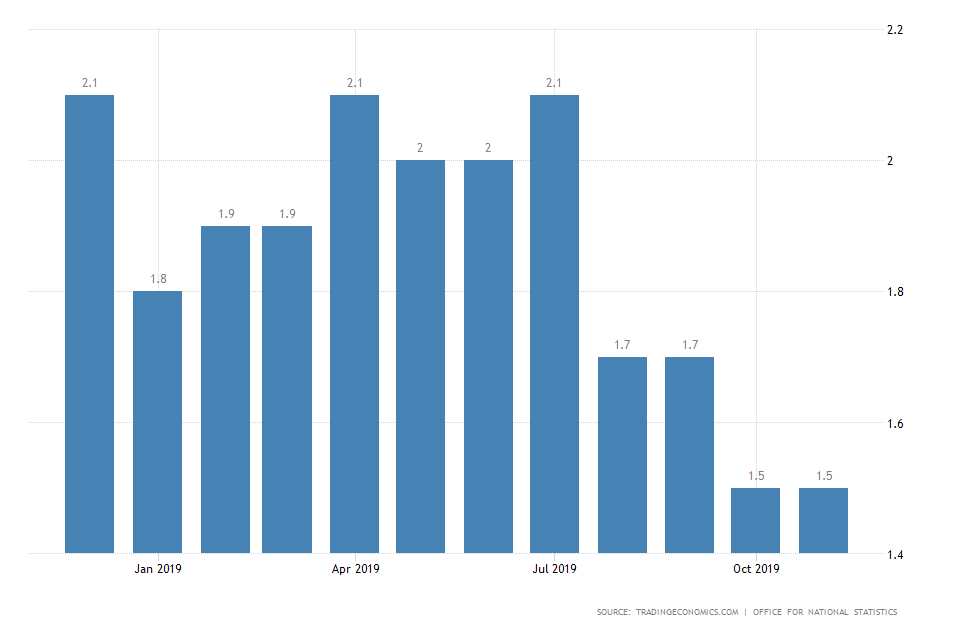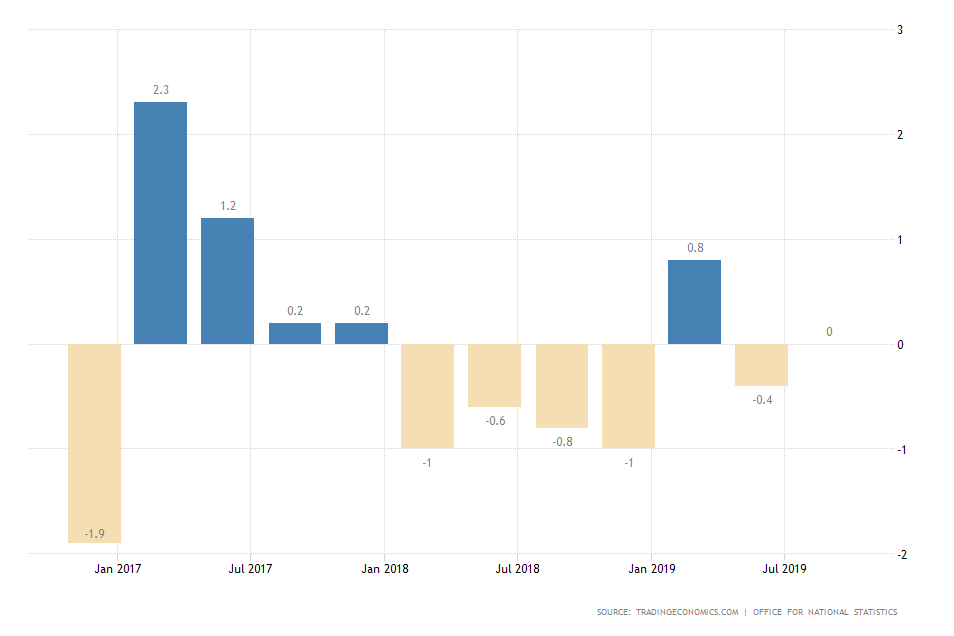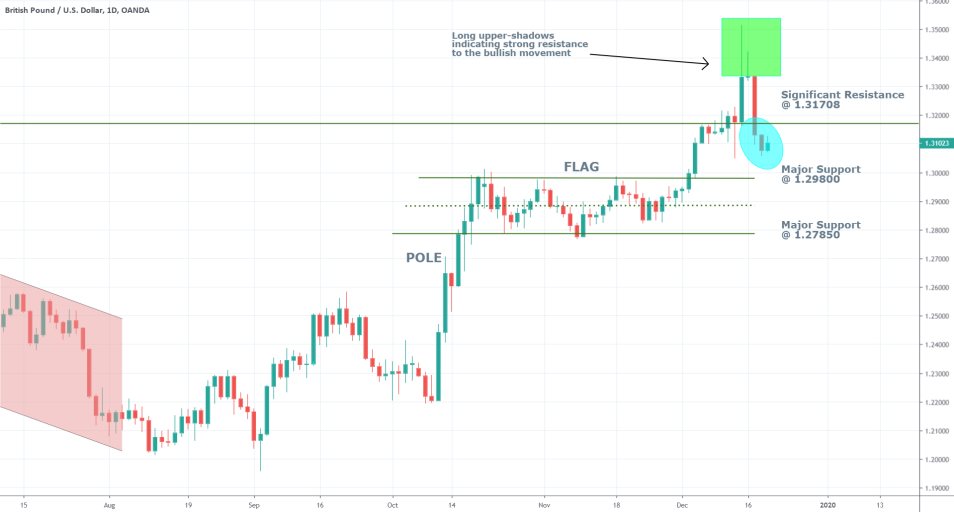
The 12-month Consumer Price Index in the United Kingdom remained at 1.5 per cent in November, unchanged from October 2019.
The findings of the inflation report, which is compiled by the Office for National Statistics, were expected, though discouraging.
Inflation in the UK continues to be muted and way below the Bank of England’s 2 per cent target level, as the slump in global trade and uncertainties over Brexit negotiations continue to weigh down on internal business activity.

The observed muffled inflation for the second consecutive period – fourth below the BOE’s target-range – is exhibitive of the weakening price stability in the country, which is driven by shaken investors’ confidence.
Part of the economy has been experiencing a recovery over the past few weeks, which was mostly driven by the expectations for a majority victory of Boris Johnson’s party in the recent elections.
The core reason for that was the anticipation that the overall uncertainties over Brexit would be somewhat diminished on the conditions that the Conservatives won the majority of seats in the House of Commons.
The election victory for the Tories was more than decisive, which bolstered the pound and the British stock market. However, the gains were mostly driven by the short-term excitement of voters.
Investors and business owners, on the other hand, remain cautious and worried, as Johnson’s cabinet is expected to push Brexit forward at all costs, even if it means a no-deal divorce.
In such a scenario, the ambiguity surrounding Brexit would be finally over; however, the uncertainties over the long-term future stability of the British economy would just be starting.

That is the reason why the overall price stability in the UK, as demonstrated by the 12-month CPIH index, remains vulnerable in addition to the observed suboptimal levels of business investments within the economy.
As the initial excitement over Johnson's victory subsided, the main driving forces behind the pound's recent surge get diminished as well.
The GPUSD appears to have found a very strong resistance level, which the price is incapable of breaking through.
Instead, it has consolidated back below the significant resistance level at 1.31708 and the major support at 1.29800.
As the overall liquidity in the markets is expected to lessen over the Christmas holidays, the volatility driving the GBPUSD is also likely to fall, which means that the pair would most likely continue to trade within this narrow range until the end of the year.

Trendsharks Premium
Gold is undergoing a correction, as investors take profits to offset losses from falling stock prices, impacting their margins. However, we anticipate a renewed wave of [...]
The Swiss stock market index is mirroring its global counterparts, such as Germany 40 and US100, experiencing a sharp decline following the announcement of new [...]
We’re analyzing the weekly chart to grasp the broader market trend. Over the past three years, the US30 index has surged by 17,000 points, often resembling a nearly straight [...]
Over the past week, the DAX has experienced a sharp decline, plunging by an astonishing 3,400 points. This downward movement is not isolated, as its international counterparts, such as the UK100 and US100, are also facing significant [...]
EURUSD recently formed a double top at 1.0930, signaling a potential trend reversal, and has since begun a correction. After a 600-pip rally since early March, a pullback at this stage is both expected and healthy. Given these conditions, we are placing a [...]
Since early March, EURJPY has surged nearly 1,000 pips, providing us with several excellent trading opportunities. However, as the rally matures, many early buyers are beginning to take profits, leading to a noticeable slowdown in the uptrend. On Friday, the pair formed a [...]
The AUDJPY currency pair continues to be dominated by bullish momentum, as multiple golden cross patterns reaffirm the strength of the ongoing uptrend. Despite this, we are witnessing a much-needed [...]
The EURAUD currency pair appears to be undergoing a trend reversal, signaling a potential shift in market direction. A notable technical development is the formation of a Death Cross on the chart, a widely recognized bearish indicator that typically suggests a [...]
After securing an impressive 200-pip profit last week, the EURJPY currency pair is now undergoing a southward correction, retracing some of its recent gains. Despite this temporary pullback, the Golden Cross remains intact, reinforcing our view that the overall trend continues to be [...]
The appearance of a Golden Cross in Silver strengthens our analysis that the metal is currently in a strong uptrend, indicating further bullish momentum in the market. This technical pattern, where the short-term moving average crosses above the [...]
This trade presents a considerable level of risk and can be classified as an opportunistic move based on recent price action. The GBPUSD currency pair has experienced a substantial bullish rally, surging by nearly 500 pips in a strong upward movement. However, after this extended period of appreciation, the pair is showing signs of a potential [...]
The anticipated Death Cross on the SMI20 appears to be failing as price finds strong support at the 23% Fibonacci retracement level. After testing this area, the index has shown bullish strength, printing several large green candles, signaling an increase in [...]
A Golden Cross has just appeared on the USDJPY chart, signaling a potential bullish move. This technical pattern occurs when the 20 period moving average crosses above the 60 period moving average, a widely recognized indication of increasing [...]
After 2 months of a down trend, we finally see some indications of price recovery for Oil. The golden cross, a historic buy signal, supports this [...]
For the past month, the German DAX40 has experienced a remarkable 10% surge, reflecting strong bullish momentum. Despite ongoing market volatility and frequent pullbacks, every dip continues to attract fresh buyers, reinforcing the [...]
Oil continues its downward trajectory, despite occasional pullbacks. The overall trend remains bearish, reinforced by multiple Death Cross patterns, a classic sell signal indicating further weakness. Adding to this bearish outlook, the critical [...]
Over the past few days, gold has experienced a sharp decline of more than $100. This downturn can be attributed in part to traders securing profits to manage their margins, which are under strain due to the significant drop in major indices. Currently, gold has fallen below the [...]
The NASDAQ 100 index is showing strong bullish momentum, as evidenced by the formation of a Golden Cross on the chart. This classic buy signal occurs when the short moving average crosses above the long term moving average, suggesting that upward momentum is [...]
The EURAUD currency pair has encountered a significant resistance level, failing to break above the critical 61% Fibonacci retracement level. This suggests that bullish momentum is weakening, reinforcing the case for a potential downward move. Given this technical setup, we favor entering a [...]
The UK100 is experiencing a remarkable rally! Over the past few weeks, the British stock market index has surged nearly 800 points. Each minor dip has attracted more buyers, fueling the bullish momentum. However, since last week, we’ve observed a slight [...]




















